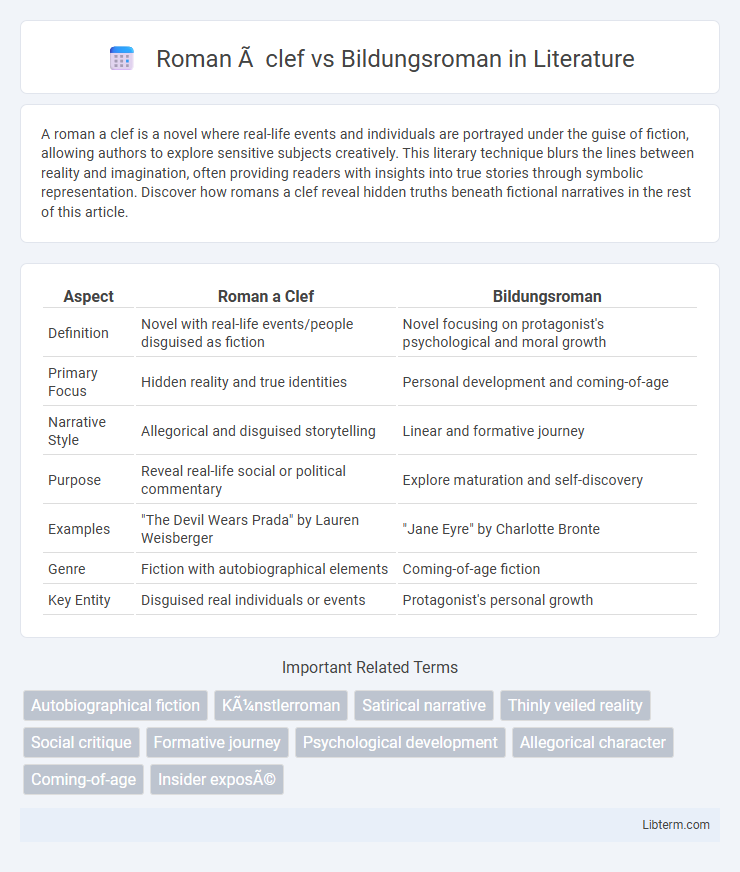A roman a clef is a novel where real-life events and individuals are portrayed under the guise of fiction, allowing authors to explore sensitive subjects creatively. This literary technique blurs the lines between reality and imagination, often providing readers with insights into true stories through symbolic representation. Discover how romans a clef reveal hidden truths beneath fictional narratives in the rest of this article.
Table of Comparison
| Aspect | Roman a Clef | Bildungsroman |
|---|---|---|
| Definition | Novel with real-life events/people disguised as fiction | Novel focusing on protagonist's psychological and moral growth |
| Primary Focus | Hidden reality and true identities | Personal development and coming-of-age |
| Narrative Style | Allegorical and disguised storytelling | Linear and formative journey |
| Purpose | Reveal real-life social or political commentary | Explore maturation and self-discovery |
| Examples | "The Devil Wears Prada" by Lauren Weisberger | "Jane Eyre" by Charlotte Bronte |
| Genre | Fiction with autobiographical elements | Coming-of-age fiction |
| Key Entity | Disguised real individuals or events | Protagonist's personal growth |
Introduction: Defining Roman à Clef and Bildungsroman
Roman a clef is a literary genre where real-life people and events are depicted under the guise of fiction, allowing authors to explore true stories with creative freedom and anonymity. Bildungsroman focuses on the protagonist's psychological and moral growth from youth to adulthood, emphasizing personal development and self-discovery. Both genres use narrative techniques to reveal inner truths, but Roman a clef centers on real-world parallels, while Bildungsroman highlights character evolution.
Historical Origins of Roman à Clef
Roman a clef traces its historical origins to 17th-century France, where authors disguised real-life events and figures through fictional characters to evade censorship and political repercussions. Unlike Bildungsroman, which focuses on the psychological and moral growth of the protagonist, Roman a clef embeds actual historical and social contexts within a thin veneer of fiction. This genre uniquely blends real-world documentation with narrative storytelling, offering a semi-coded critique of contemporary society.
The Evolution of the Bildungsroman Genre
The Bildungsroman genre, characterized by its focus on the psychological and moral growth of the protagonist, has evolved from its 18th-century origins to incorporate diverse narrative styles and themes. Unlike the Roman a clef, which veils real-life figures behind fictional characters, the Bildungsroman emphasizes internal development and self-discovery within fictional contexts. Contemporary Bildungsromans often blend social critique and cultural identity, reflecting the genre's adaptive evolution in modern literature.
Key Features of Roman à Clef Narratives
Roman a clef narratives use real-life events and individuals disguised beneath fictional names, offering insider perspectives while maintaining plausible deniability. These stories often reveal behind-the-scenes political, social, or artistic relationships, making them valuable for decoding historical contexts. The key feature is the thin veil of fiction that invites readers to interpret and identify true characters and occurrences.
Central Themes in Bildungsroman Literature
Bildungsroman literature centers on the protagonist's psychological and moral growth from youth to adulthood, exploring themes of identity, self-discovery, and personal development. The narrative typically depicts challenges in forming a coherent self amid societal pressures, emphasizing education, mentorship, and internal conflict. Unlike Roman a clef, which encodes real-life figures in fictional form, Bildungsroman prioritizes the evolution of the character's inner life and social integration.
Real Life and Fiction: Purpose of Roman à Clef
Roman a clef novels blend real-life events and people with fictionalized storytelling, allowing authors to explore personal or controversial topics under the guise of fiction. This genre provides a veil of anonymity that protects both the writer and subjects while offering readers insight into true historical or social realities. Unlike Bildungsroman, which emphasizes character development and personal growth, Roman a clef focuses on revealing hidden truths about real-life individuals and situations.
Personal Growth and Self-Discovery in Bildungsroman
Bildungsroman centers on personal growth and self-discovery, tracing the protagonist's psychological and moral maturation from youth to adulthood. This genre highlights internal development, emphasizing identity formation and emotional resilience through life experiences. In contrast, Roman a clef primarily reveals real-life events and individuals disguised within fictional narratives, focusing less on the protagonist's inner transformation.
Notable Examples: Roman à Clef vs Bildungsroman
Notable examples of Roman a clef include "The Bell Jar" by Sylvia Plath and "The Sun Also Rises" by Ernest Hemingway, where real-life figures and events are fictionalized under thin disguises. In contrast, notable Bildungsroman works like "Jane Eyre" by Charlotte Bronte and "David Copperfield" by Charles Dickens focus on the protagonist's psychological and moral growth from youth to adulthood. The Roman a clef often explores social and political realities through personal narratives, whereas Bildungsroman emphasizes character development and coming-of-age themes.
Literary Impact and Cultural Significance
Roman a clef offers a unique literary impact by blending real historical figures and events with fictional narratives, providing readers with an intimate glimpse into actual cultural and political climates, enhancing interpretative depth. Bildungsroman, emphasizing the psychological and moral growth of the protagonist, significantly influences cultural understanding of human development, identity formation, and societal values across various eras. Both genres hold distinct cultural significance; Roman a clef documents historical and personal realities through fiction, while Bildungsroman shapes collective self-awareness and empathy through character evolution.
Conclusion: Comparing Two Distinct Narrative Forms
Roman a clef and Bildungsroman offer distinct narrative approaches, with Roman a clef embedding real-life events and figures behind fictionalized representations, while Bildungsroman traces the protagonist's psychological and moral growth. Both serve unique literary functions: Roman a clef reveals hidden truths through allegory, whereas Bildungsroman emphasizes character development and self-discovery. Understanding these differences enhances appreciation of how narrative form shapes thematic exploration and reader engagement.
Roman à clef Infographic

 libterm.com
libterm.com